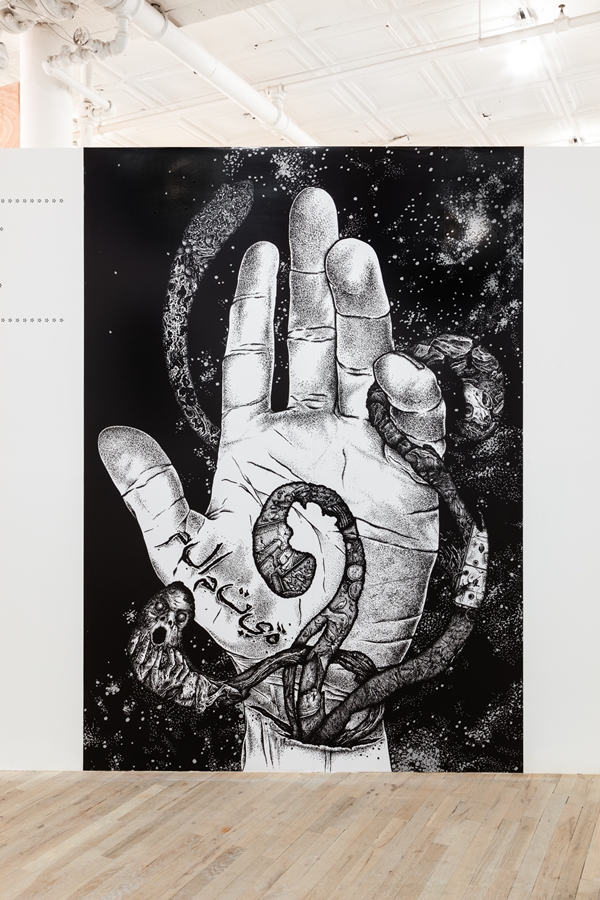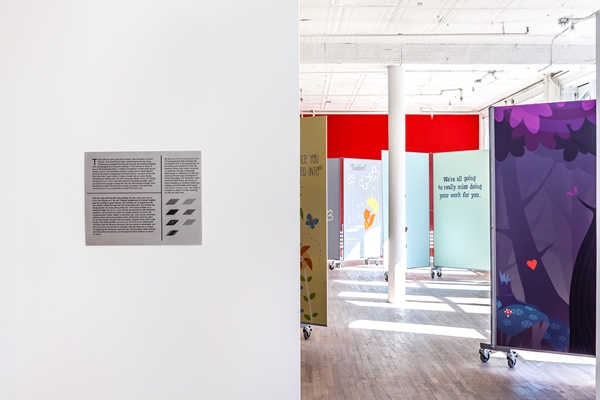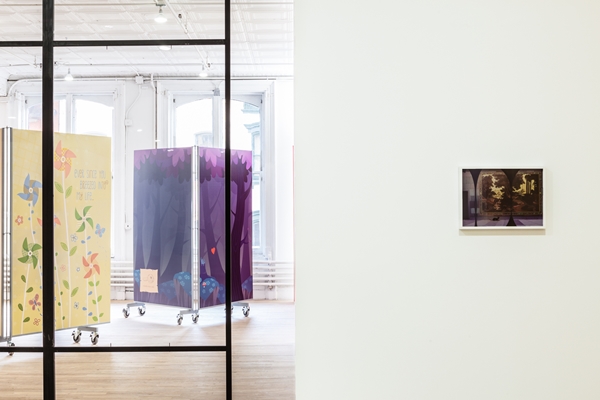Art & Exhibitions
Getting Lost in Sam Pulitzer’s Artists Space Maze
This is one labyrinth you'll be eager to escape from.

This is one labyrinth you'll be eager to escape from.

Jeffrey Grunthaner


Sam Pulitzer, installation view of “A Colony for ‘Them'” (2014) at Artists Space.
Photo: Daniel Pérez.
Sam Pultizer’s “A Colony for ‘Them’” at Artists Space (through May 18) includes several vinyl print illustrations commissioned from various artists, as well as poetic texts and a some large-scale installations. The space feels somehow boxed-in and boundless simultaneously, and you might think you’ve stepped inside a three-dimensional map of utopia.
Pulitzer’s exhibition is really that strange—and that literary. Poetry is everywhere in his colony, whether adorning the walls like neatly typed graffiti, or etched into silver wall plaques. You sometimes have to hunt for it, as text might be hidden in a corner somewhere, but the suggestion of narrative serves as a guiding thread throughout the show.

Sam Pulitzer, installation view of “A Colony for ‘Them'” (2014) at Artists Space.
Photo: Daniel Pérez.
It’s unfortunate, then, that the art on view doesn’t measure up to the poetry. As a concept, the idea of exhibiting the work of others rather than your own work seems radical enough. But what Pulitzer has actually done is take on the role of a curator—one with very uneven taste. Among the nine or so illustration pieces in the show, the only one that really stands out is by Simon Fowler, largely for the way it incorporates the viewer into the stratified space it portrays. There’s a large blossoming of red in the center of the print, which seems to move outward into the matrix that surrounds it. The concentric beauty of Fowler’s print is missing from the rest of the exhibition.

Sam Pulitzer, installation view of “A Colony for ‘Them'” (2014), featuring work by Viral Graphics, at Artists Space.
Photo: Daniel Pérez.
“A Colony for ‘Them’” raises questions regarding place, position, and belonging, but provides no viable answers. The thread of poetry that runs through the show, with its use of the inclusive pronoun “you”—e.g. “You are waylaid in a treacherous swamp. The barely solid ground you stand on slowly shifts with the lethargic currents, covered in a thick green carpet of mould”—isn’t enough to draw viewers into the kind of world the prints disclose. However large-scale, the illustration works actually deny a sensation of depth visitors might otherwise experience, feeling too otherworldly and flat to sustain the spatial precedent created by the labyrinthine environment.
By contrast, the installations do feel well-placed. Especially one tucked away in a corner: a kind of wooden encampment with a place-to-flop quality about it. Given the pedestrian nature of a labyrinth, walking to the center and then out again, it forms a vital extension of the show’s overarching design.
Sam Pulitzer’s “A Colony for ‘Them'” continues at Artists Space through May 18.

Sam Pulitzer, installation view of “A Colony for ‘Them'” (2014) at Artists Space.
Photo: Daniel Pérez.